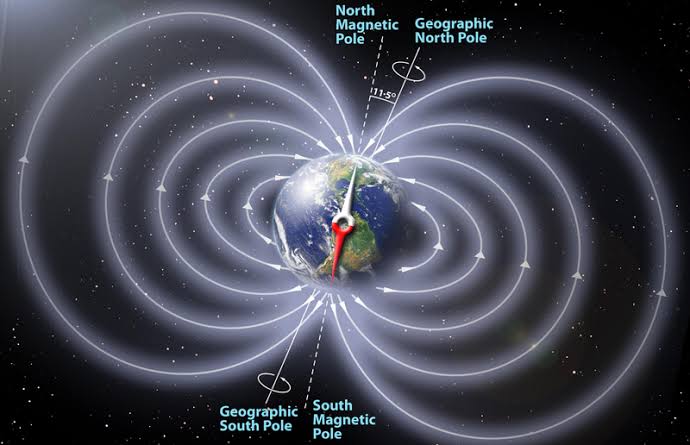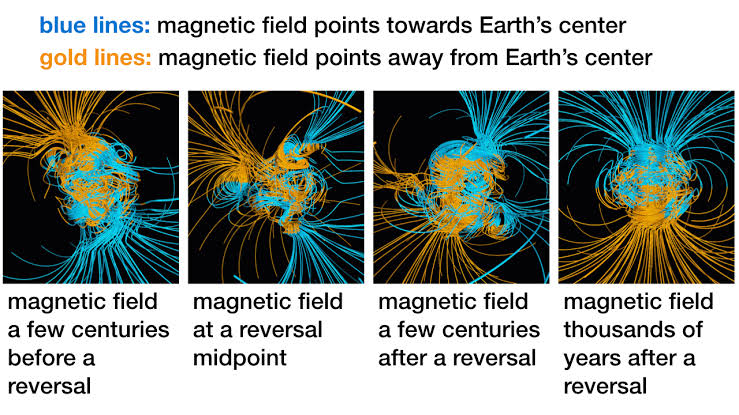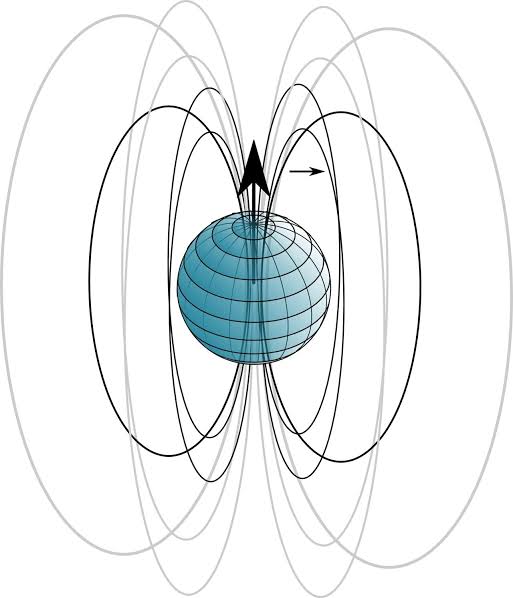A compass needle rotates and always aligns in such a way that it is pointing towards the north pole. This phenomenon has been used for navigation for centuries and is still used today. Why does this happen? This happens because of Earth’s magnetism.
The Magnetic Field Of The Earth:

The Earth has a magnetic field produced by the motion of molten iron in its core, where temperatures exceed 5,000 degrees Celsius. The molten iron swirls around in the core, creating a dynamic environment. This dynamic environment acts like a dynamo, generating Earth’s global magnetic field.
As the molten iron in the core moves, it generates electric currents that produce the magnetic field. It is a natural phenomenon that surrounds the earth and protects us from solar and cosmic radiation. The magnetic field is invisible to the naked eye, but its effects can be seen in the behaviour of magnetic materials and in the way that many animal species use it for navigation.
Importance:
The magnetic field is essential to life on Earth because it acts as a shield against the charged particles that are constantly bombarding our planet from the sun and beyond. These charged particles can cause damage to electronic equipment and can be harmful to human health. Without the magnetic field, life on Earth would be much more challenging.
The magnetic field deflects some of the charged particles away from the Earth, but others can become trapped in the magnetosphere, a region of space surrounding the Earth that is shaped by the magnetic field. When these particles collide with atoms in the upper atmosphere, they can create auroras, which are a beautiful natural phenomenon.
Additionally, many animal species, such as birds, sea turtles, and whales, use the Earth’s magnetic field for navigation. These animals have specialized cells called magnetoreceptors that allow them to detect the magnetic field and use it to orient themselves during migration or foraging.
Related: Cosmic rays and their effects on humans and technology in space
Earth’s Magnetic Field And Variations:

The Earth’s magnetic field is known to be a dynamic feature that can undergo variations in strength, direction, and polarity. Scientists have been studying these variations for many years, and their research has revealed that the magnetic field is not a fixed entity.
The strength of the magnetic field has been observed to fluctuate significantly over the past century, with some regions exhibiting greater variations than others. For instance, the South Atlantic Anomaly is an area where the magnetic field is particularly weak, which can pose a challenge for satellites and spacecraft that pass through it. The strength of the magnetic field has been observed to vary by as much as 50% over the past century. These variations are not evenly distributed across the globe.
The direction of the magnetic field is also subject to variations, and over the past 400 years, the magnetic north pole has been observed to move slowly across the northern hemisphere. In recent years, this movement has accelerated, and the magnetic north pole is currently moving towards Siberia at a rate of around 55 km per year.
Furthermore, the polarity of the magnetic field can also vary, and the north and south magnetic poles can swap places gradually over thousands of years. During this time, the magnetic field can become unstable and weaken, which can impact our planet’s protective shield against harmful solar radiation.
Related: Earth Has A 27.5-million-year ‘Heartbeat,’ But No One Knows Why
Effects Of The Heat Flow On The Magnetic Field:
The Earth’s magnetic field is powered by the movement of molten iron in the core, which generates electric currents that create the field. However, the heat flow from the core is a crucial factor in maintaining the temperature gradient between the core and the mantle, which drives the motion of molten iron.
As the core cools, it loses heat to the mantle, which can alter the rate of convection and the composition of the core. These changes have significant implications for the strength and direction of the magnetic field, which in turn affects Earth’s environment and ability to protect against harmful radiation. Therefore, understanding the impact of heat flow on the magnetic field is essential for predicting the behavior of the Earth’s magnetic field and its potential effects on the planet.
Conclusion:
Magnetic fields are a fundamental force of nature that plays a vital role in many aspects of our lives. Understanding how magnetic fields vary in different environments and under different conditions is essential for developing new technologies and solving many scientific and engineering challenges.
Whether it’s studying the Earth’s magnetic field to better understand our planet’s geology and atmosphere, or developing new magnetic storage devices for computers and other electronics, the study of magnetic fields and their variations has far-reaching implications. As research in this field continues, we can expect to gain new insights into the complex and fascinating world of magnetism, and develop new technologies that will transform our world in exciting and unexpected ways.
